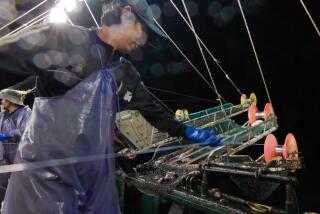But Shellfish Now Face Extinction : Chilean Abalone Is Smugglers’ Delight
- Share via
VALPARAISO, Chile — Smugglers are trafficking in abalone, a Pacific Ocean shellfish widely regarded as a delicacy but whose survival in Chilean waters is endangered.
The government has banned fishermen from catching them in most of Chile, but the ban is difficult to enforce, said Capt. Ivan Petrowitsch, a naval officer who is director of the National Fishing Service.
“There are gangs all over the place,” he added in an interview in this port city. “They are very difficult to control. Unless this stops, the Chilean abalone faces extinction.”
“Twenty years ago you could find abalone in Chile at a depth of two meters (6 1/2 feet),” he said. “Today you have to go down to 20 meters (65 feet).”
Like Drug Trafficking
Officials say the smugglers are using sophisticated vehicles and communications gear, like those usually associated with drug trafficking.
Petrowitsch said his agency, which is charged with enforcing the ban, has only 167 inspectors to combat the smuggling.
The ban on all abalone fishing was imposed earlier this year until next June in nine of the 12 Chilean coastal provinces. Abalone fishing remains legal in the far south but with some restrictions. The smugglers transport illegal abalones to the southern zone, claiming that they were legally caught there, and then sell them.
The law calls for fines for not only unauthorized abalone catching and processing but even for the mere possession of an illegal abalone. Fishing companies and exporters convicted under the decree can be shut down.
‘Law Not Respected’
“The law is not respected,” Petrowitsch said. “Whenever something becomes illegal, unscrupulous people always find a way to make money from it.”
According to Chile press reports, smugglers pay poor Chilean fishermen and divers 100 pesos (54 cents) for each illegal abalone they supply. By the time the abalone is cleaned, bottled in brine or frozen, it can bring as much as $8 in New York City or Tokyo.
Last year Chile earned $23 million from legal abalone exports--92% of the officially registered catch here is shipped abroad. The biggest customer is Japan, followed by the United States, Taiwan and Hong Kong.
Chile is the world’s largest abalone producer. Even though the catch here dropped from 20,000 tons in 1982 to 11,000 tons last year, it still far outstripped that of No. 2 producer Australia, which according to the United Nations Food and Agriculture Organization produces 6,500 tons annually.
A Unique Taste
Petrowitsch explained that in the legal southern fishing zone, abalone still exists in sufficient numbers. The problem, he said, is that the mollusks can be found clinging to rocks all along Chile’s 2,650-mile Pacific Coast.
He said traffickers often forge government documents showing the abalones’ place of origin as being in the southern zone.
Chile says its variety of abalone, known in Spanish as loco , has a unique taste because it is the only one in the world that is carnivorous, sucking in tiny mollusks and fish. Experts here say abalones from Australia, New Zealand, Japan, Mexico and the United States feed on underwater plants.
More to Read
Sign up for Essential California
The most important California stories and recommendations in your inbox every morning.
You may occasionally receive promotional content from the Los Angeles Times.










